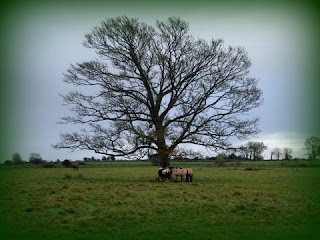The roads in southern Ireland nearly all look alike-adorned by green hummocky fields, low stone walls called poetically "Galway lace" and crumbling ruins.
But standing out from the soft countryside is the occasional monolith, a majestic landmark-like St. Clerans.
"I lived there for eighteen years," reflected film director John Huston when I met him in 1973. St. Clerans was a testimony to Huston's taste-and his love of Ireland. "I fell for the country before I knew about St. Clerans," said Huston. "I came to Ireland every chance I could get. Once I rode past St. Clerans, which was a real wreck; but I had to have it." He bought the ruin complete with its own mini-ruin the crumbling wall of an eleventh-century monastery. And he acquired Irish citizenship as well.
The house itself was built on the monastery site in the 18th century, and Huston remembered with a shudder what it first looked like to him. "It had an awful-looking layer of decorations-yesterday's Victorian icing-all over it." He had that removed, and what remained was the Georgian structure.
St. Clerans came complete with its own ghost story. A family called Burke owned the house for many years. Burke was a judge who sentenced a local man called Daly to be hanged. Daly's widowed mother put 'the widow's curse' on the Burkes and their house, swearing that never again would a Burke die in his bed or a rook nest at St. Clerans. Years after Daly was hanged, someone else confessed to the murder, and the local people put up a monument to Daly that could be seen from a certain window in St. Clerans. This was a window cut especially so that the women of Burke's family could witness the hanging from afar; after the hanging, the window was filled in again with stone.
Huston, advised not to open the window, went ahead and did it anyway, mainly for aesthetic reasons. And while he was never sure if the Burkes died in their beds' or violently, he was sure that rooks weren't living at St. Clerans while he was. Maybe that opened window let the ghosts in as well. Some people still swear they see a mysterious person in a brown velvet suit.
While at St. Clerans, Huston's day began with a long morning in bed, a luxurious seventeenth-century Venetian baldachino affair. But it was never a morning of leisure. Huston received a la Louis XIV -his personal assistant, journalists, novelists friends, and friends of friends. And he not only read the daily papers (sorting out off-track bets), but wrote and corrected film scripts. "I hate writing," he said. Then, the rest of the day, he pursued his various hobbies-especially painting -which he took almost as seriously as his profession. One of Huston's most impressive achievements was his art collection which made St. Clerans an informal and personal museum.
One of John Huston's most touching memories was of the time Carson McCullers came to visit before her death, when John had just completed Reflections in a Golden Eye based on the McCullers novel. "She was bedridden, and the only person we allowed to interview her was a leading Irish journalist. One of his questions was, 'What is the purpose of the artist or writer?' In all sincerity, Carson answered, 'to search for God.' There was a very solemn moment, and the old Sicilian crucifix just over the bed turned over, upside down. Carson saw this, and everybody was tongue-tied. Suddenly she began to laugh, and so did we. We literally had seizures and fits. She was a marvellous person.”
"Once when Sartre was visiting me," reminisced Huston, "I had a very eminent Catholic intellectual there at the same time-Monsignor Paddy Brown. Well, you know Sartre, suspicious of the clergy; he probably thought Paddy Brown came to proselytize him. I reassured him, but I think that he still didn't believe me. In any case, Paddy Brown told a really good dirty joke, and that did it. Sartre was sure he was to be converted!”
St. Clerans was full of memories like these, and I wonder if the new owners inherited some of these.
Huston would shuttle between the island of Lettermullen (part of Connemara) and California. Most of his time on the island he spent painting, he had only fishermen for neighbors and refused to have a telephone. As it's the westernmost point of Ireland, he said, "the next parish is Boston but I just can't leave Ireland for good," he said, "it's got me hooked."





